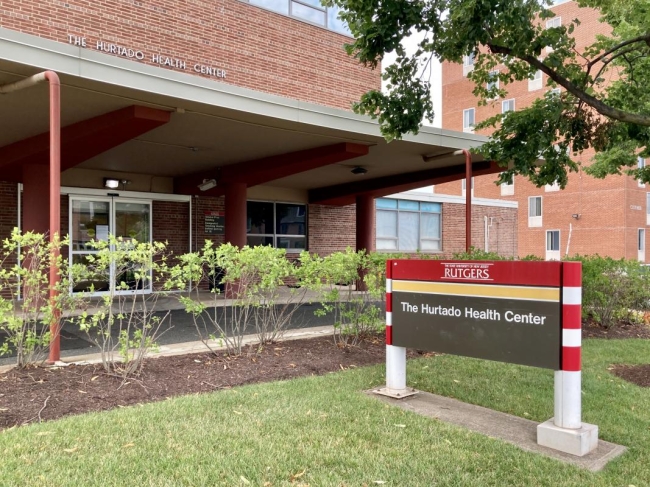You have /5 articles left.
Sign up for a free account or log in.

A health center at Rutgers University at New Brunswick
Lilah Burke
Recent survey data from the American College Health Association suggest that all is not well on college campuses when it comes to health and wellness.
Of respondents to the association’s survey who knew their health center budget allocation for the 2021 fiscal year, 43 percent said that budget would be a decrease from FY20 funding. And although 40 percent said they were expecting to hire medical professionals, nearly one-quarter said they were expecting reductions for those staff instead. Sixteen and 17 percent of respondents also said they expected staff reductions in mental health and health promotion services, respectively.
Gerri Taylor, co-chair of ACHA’s survey subcommittee, said the specter of decreased budgets is concerning. Health, counseling and wellness departments, she said, are overwhelmed right now. Flu season is coming, which requires immunizations, and students will be headed indoors more often, where COVID-19 transmission is more of a risk. If a COVID-19 vaccine becomes available, she said, health center staff will need to distribute it.
“They need great support from their administrations,” she said.
Larry Ladd, a senior consultant with the Association of Governing Boards of Universities and Colleges, said the decreased budgets may be a result of decreased demand for the most basic services university health centers offer. There are fewer students on most campuses this year, and the desire from those who are on campus to visit a health center may be decreased.
“While the COVID-19 crisis created the need for specific, specialized services, the need for other services went way down,” he said. “Universities can’t justify idle services or idle staff.”
When campus populations return to their regular numbers, budgets may increase, he said.
Taylor said she believes many people do not recognize how important staff in wellness and health promotion are, and their role in informing students.
“If you don’t have that staff, it’s problematic,” she said.
The responses were collected from 257 surveys of ACHA members at institutions around the country. The sample was comprised mainly of four-year institutions, with near equal distributions of public and private colleges, small and large colleges. Institutions in urban settings accounted for nearly half of respondents. Responses were collected Aug. 4 to 7.
Among other results, one-third of respondents said their institutions were operating residence halls at full capacity, which goes against guidance from ACHA.
That information is in line with other data collected from the Association of College and University Housing Officers -- International. That organization asked housing officials across the country to submit plans for residence halls. Many of the institutions listed on the organization’s fall housing tracker are planning for 90 to 100 percent occupancy.
The ACHA survey demonstrated that there is a wide spectrum for colleges in regard to what kind of testing they are doing and how often.
The survey revealed that many colleges are not testing students prior to arrival or asking for documentation of a negative test result before arrival. Those are measures the Centers for Disease Control and Prevention declined to recommend, but some public health officials have underlined their importance.
Testing some subset of students throughout the semester seems to be a more common approach. While only 35 percent of respondents said they were testing students upon arrival, over 70 percent said they were testing at least some students at some point in the term.
But while colleges may be testing their students, two-thirds of respondents reported that their institutions were not testing faculty and staff upon arrival.
Those statistics were collected over a month and a half ago, and Taylor said she believes many more colleges have increased the testing that they are doing. Faculty and staff are community members, and it is important to test them as a part of a campus strategy, she said.
Availability of testing is something some faculty and staff have raised concerns about. Alex Wolf-Root, president of United Campus Workers Colorado, said the University of Colorado at Boulder is among those that did not offer testing upon arrival for faculty and staff. The testing situation there is such that many employees don’t feel safe, he said.
“I’m sure a handful do, but I know many, many more don’t,” he said.
Wolf-Root said he would have supported systematic testing and pre-arrival testing for faculty and staff, along with increased testing for students at CU Boulder.
“Some of the defense of not testing everyone is we don’t have the resources,” he said. “Well, if you don’t have the resources to test everyone you need to test, you can’t open. You are not qualified to open.”
Some colleges have been providing free and available testing for their undergraduate students but requiring faculty and staff to get tested elsewhere.
“Everyone on campus should be able to get free testing whenever they need,” Wolf-Root said. “But that was not the case here, and it sounds like that was not the case at many other places.”
In more positive news for college health professionals, over 90 percent of respondents said their institution had a representative for student health, health promotion or counseling on their reopening team, and over two-thirds perceived the representative’s input as highly regarded by the administration.
“[Health, counseling and wellness staff] are in the trenches,” said Taylor. “It was gratifying to see they are valued.”




